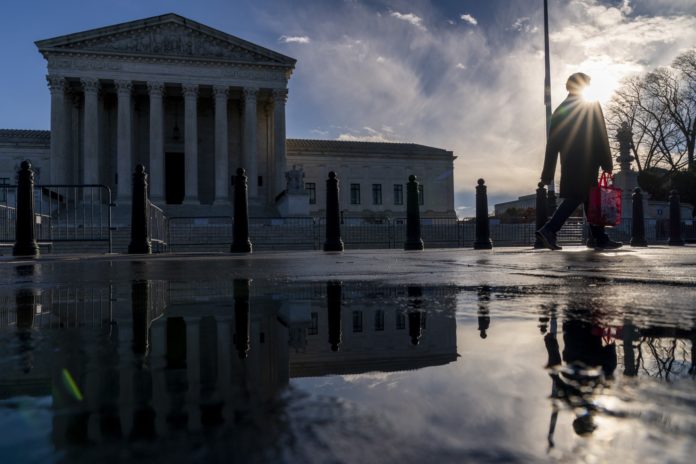
By Caitlyn Meisner | Copy Editor
The Supreme Court has heard oral arguments for two cases concerned with using race as a factor in college admissions against Harvard College — the undergraduate liberal arts program of Harvard University — and the University of North Carolina, and now must decide whether it is necessary and justifiable to consider race during the admissions process.
The cases were brought against the two institutions by Students for Fair Admissions, an organization that aims to eliminate race and ethnicity from the college admissions process. The organization said both universities give preference to underrepresented minorities, which is a detriment to white and Asian Americans.
“What Harvard is doing to Asians, like what it was doing to Jews in the 1920s, is shameful, but it’s a predictable result of letting universities use race in highly subjective processes,” Cameron Norris, the lawyer arguing on behalf of Students for Fair Admissions against Harvard, said in the oral documents.
The oral arguments by both lawyers for Students for Fair Admissions, Harvard College and the University of North Carolina were heard on Oct. 31, 2022 by the nine Supreme Court justices.
Greg White, senior lecturer in the Baylor law school, said these cases brought forward by Students for Fair Admissions want to overrule precedent set by the court in previous cases, such as Grutter v. Bollinger in 2003.
White explained a potential overrule in precedent is similar — but not identical — to overruling Roe v. Wade back in June 2022. He said the court only overrules their cases in “extraordinary circumstances.”
“First, they say the older opinion must be grievously wrong,” White said. “The old case must impose significant, negative, real world consequences and by overruling it, they will not upset interests that rely on the old case. It is not just a question of should we allow race in college admissions, should we do so by changing what the law has been for decades?”
Dr. Curt Nichols, associate professor of political science, said there is a long history of affirmative action cases that have reached the Supreme Court in the past.
Nichols said the court has heard several cases throughout the years that present various ways college admissions should approach race in students. He said there have been cases about using a quota system — reserving seats for students of color — and point systems — rewarding point values to characteristics and test scores — that have both been ruled against.
He said the standard used by colleges and universities is a holistic review of each candidate and their application. The opinion written by the majority in Grutter v. Bollinger, which ruled in favor of the school, said the school conducts such a highly individualized review, so a decision is not based automatically on a single variable and many factors contribute to diversity of a given class.
Both Harvard and University of North Carolina argued before the Supreme Court they use race as a factor in the admissions process, but adhere to the requirements outlined by the decision in Grutter v. Bollinger to create a diverse class.
“The university pursues these interests in scrupulous compliance with this court’s precedents, which have consistently held for decades that seeking the educational benefits of diversity is a compelling interest of the highest order and universities may consider all aspects of an applicant’s background to build a thriving campus community,” Solicitor General of North Carolina Ryan Park, the lawyer that argued on University of North Carolina’s behalf, said in the oral argument to the Supreme Court on Oct. 31, 2022.
Brian Serr, professor of constitutional law, said SFFA argued for race-blindness when it came to admissions, particularly when it comes to “checking a box.”
“Personal statements provide a unique perspective as well,” Serr said. “You can attach weight to these and it can produce richer and deeper diversity despite looking at race at face value.”
In the oral arguments, Norris said culture, tradition and heritage are not off limits, but universities need to credit “something unique and individual” and not race itself.
“Universities just cannot consider race itself,” Norris said. “We’re objecting to the use of race as either a plus or a minus in making admissions decisions.”
Serr said he believes the court will rule in favor of Students for Fair Admissions and make any conscious consideration of race as an advantage or disadvantage unconstitutional.
White said he cannot predict what the court will decide in June.
“I think people that try and predict things based on what they’ve done in one case and say, ‘well, they overruled precedent in one case, so they must be willing to do it every case,’ are false,” White said. “I think they take each case on its own and measure it against the same standards.”
Whichever way the court decides to go, private schools such as Baylor will inevitably be impacted. The National Association for Independent Colleges and Universities said private universities are just as susceptible to legal challenges on required grounds if they receive federal funds.
“Under Title VI of the Civil Rights Act, private colleges and universities that receive federal funding are prohibited from discriminating on the basis of race, color or national origin,” the National Association for Independent Colleges and Universities website said.
Baylor receives federal funds from the federal work-study program on campus and recently received $1.5 million from the federal government to purchase equipment for a cybersecurity program.
“Because the federal courts have ruled that Title VI forbids the same activities that are prohibited under the Constitution, affirmative action programs at private institutions therefore must meet the same legal standards that apply to public schools,” the National Association for Independent Colleges and Universities website said.
Baylor Spokesperson Lori Fogleman said Baylor’s Strategic Enrollment Management plan outlines their goal to increase enrollment of underrepresented students on campus.
“Baylor differs in that race is not a factor at the time of an admission decision,” Fogleman said.





